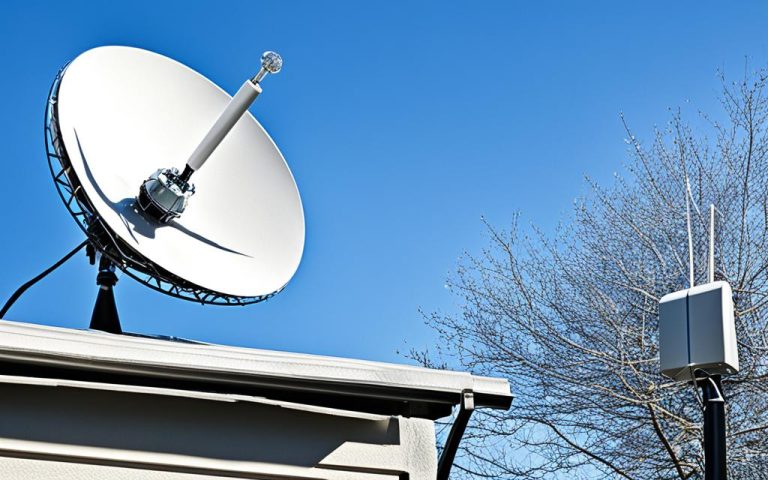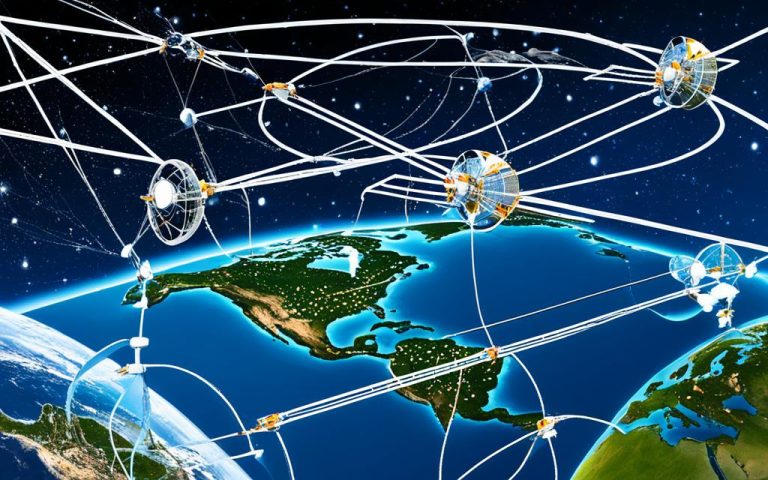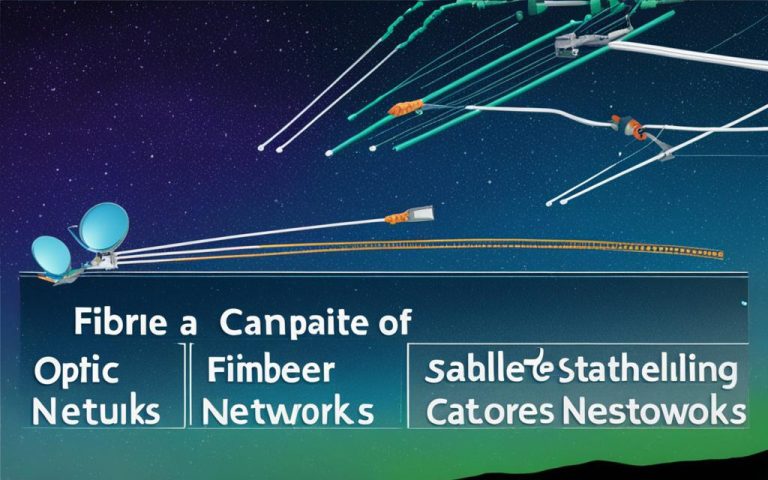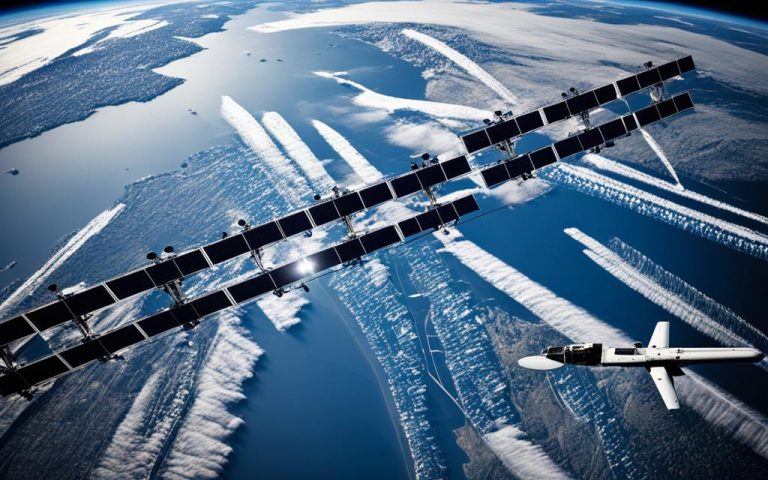Satellite networks and 5G are converging to offer seamless global connectivity. The integration of these two technologies is crucial for achieving the full potential of 5G networks. While terrestrial telecommunications systems have their limitations, integrating satellite and terrestrial systems is necessary to fulfill the increasing demands of future 5G networks, including coverage in rural and remote areas, connectivity for devices on the move, and edge computing.
In this article, we will explore the role of satellites in 5G networks and the weaknesses of 5G that necessitate satellite integration. We will also delve into how satellites and 5G work together, their integration in different types of communication, and the significance of satellite networks for achieving ubiquitous 5G connectivity.
The Role of Satellites in 5G Networks
Satellites play a crucial role in enabling the full potential of 5G networks. While terrestrial systems dominate in cities and city-to-city communications, satellites are essential for expanding coverage in rural and remote areas, providing connectivity for devices on the move, and supporting edge computing.
One of the key advantages of satellites in 5G networks is their ability to solve the “last mile” problem. In areas where terrestrial infrastructure is limited, satellites can bridge the gap, ensuring that even remote locations have access to high-speed internet.
Satellites also play a critical role in providing redundancy for critical emergency services. In times of natural disasters or network failures, satellites can step in to maintain communication and ensure that emergency response teams stay connected.
Furthermore, satellites enable edge networking, which brings the network closer to the end users. This reduces latency and allows for faster data transmission, enabling real-time applications and services. Satellites also excel at handling IoT dense traffic, ensuring that the growing number of connected devices can function seamlessly in the 5G ecosystem.
“Satellites serve a variety of purposes, including solving the ‘last mile’ problem, redundancy for critical emergency services, edge networking, and handling IoT dense traffic.”
The integration of satellite and terrestrial components in 5G networks is vital in determining the type and degree of connectivity that can be achieved globally. By combining the advantages of both systems, 5G networks can provide ubiquitous connectivity, reaching even the most remote corners of the world.
Benefits of Satellite Integration in 5G Networks:
- Expanding coverage in rural and remote areas
- Providing connectivity for devices on the move
- Supporting edge computing and reducing latency
- Ensuring redundancy and reliability for critical emergency services
- Handling IoT dense traffic and enabling seamless communication for connected devices
Weaknesses of 5G that Necessitate Satellite Integration
While 5G networks promise incredible speeds and low latency, they also have certain weaknesses that make satellite integration necessary. These weaknesses include limited coverage, vulnerability to interference, limited range, and easy detection. In remote or rural areas, the signals of 5G networks may be weak or non-existent, making it challenging to establish reliable communication.
Satellites, on the other hand, offer significant advantages in terms of range and resilience against interference and detection. By integrating satellite communications with 5G networks, these weaknesses can be overcome, especially in critical operations where reliable connectivity is essential. Satellites provide broader coverage and ensure secure and reliable communication, even in remote and challenging environments.
| Weaknesses of 5G | Satellite Integration | |
|---|---|---|
| 1 | Limited Coverage | Broad Coverage |
| 2 | Vulnerability to Interference | Resilience against Interference |
| 3 | Limited Range | Extended Range |
| 4 | Easy Detection | Enhanced Security |
By combining the strengths of satellite communications and 5G networks, seamless and reliable communication can be established, ensuring connectivity in even the most challenging scenarios.
How Satellites and 5G Work Together
Satellites and 5G networks can seamlessly integrate to provide complementary capabilities for reliable, secure, and high-speed communication. The combined power of satellite and 5G technologies enables enhanced connectivity, ensuring efficient communication across different distances and environments.
Satellites are particularly well-suited for long-distance communication, offering global coverage and extending connectivity to remote and challenging areas. They provide redundancy, resilience, and broad geographical reach, making them essential for maintaining communication stability and continuity in the face of disruptions.
On the other hand, 5G networks excel in providing high-speed, low-latency communication for data-intensive applications. With their shorter-range connectivity capabilities, 5G networks optimize communication within densely populated areas and urban environments.
By integrating satellite and 5G networks, their individual strengths can be harnessed to overcome their respective limitations. Satellites broaden the reach of 5G networks, ensuring connectivity beyond urban areas and delivering ubiquitous communication capabilities. At the same time, 5G networks enhance the speed and efficiency of data transmission, enabling real-time communication and supporting emerging technologies such as autonomous vehicles and smart cities.
This integration enhances security, connectivity, and adaptability for a wide range of communication requirements. It enables seamless communication across different distances, from remote locations to urban centers, ensuring that individuals, businesses, and industries can stay connected in a fast-paced, digitally-driven world.
“The integration of satellite and 5G networks unlocks new possibilities for global connectivity, offering reliable and secure communication solutions that cater to diverse needs.”
In summary, the collaboration between satellites and 5G networks creates a powerful synergy that brings significant benefits to the ever-growing demand for seamless and ubiquitous connectivity. Combined, these technologies provide the necessary infrastructure to support the increasing reliance on data-intensive applications, IoT devices, and emerging technologies. The integration of satellite and 5G networks paves the way for a more connected and digitally inclusive future.

| Benefits of Satellite and 5G Integration | Satellites | 5G Networks |
|---|---|---|
| Global Coverage | ✔️ | ❌ |
| Redundancy | ✔️ | ❌ |
| Resilience | ✔️ | ❌ |
| High-Speed Communication | ❌ | ✔️ |
| Low-Latency | ❌ | ✔️ |
| Improved Connectivity | ✔️ | ✔️ |
Satellite Integration in Different Types of Communication
The integration of satellites in 5G networks brings benefits to various types of communication requirements. In a military setting, satellite and 5G integration allows seamless communication across multiple networks, ensuring ubiquitous communication capabilities across different geographies and terrains. It enhances tactical communication by providing real-time data exchange and situational awareness to military personnel.
The integration of satellites and 5G also enables communication across different devices, allowing soldiers to stay connected using a variety of mobile devices and sensors. In the field, where connectivity is often limited or unreliable, satellite integration ensures continuous communication even in challenging environments.
“Satellite integration in military operations enables reliable communication across multiple networks and enhances communication capabilities across different geographies and terrains,” says Michael Douglas, a military communications expert.
“Satellite integration in the military plays a critical role in maintaining communication in remote areas and enabling operations that require global connectivity. It ensures seamless communication between ground forces, naval fleets, and aircraft, enhancing command and control capabilities.”
Benefits of Satellite Integration in Military Communication
The integration of satellites and 5G in military communication provides several key benefits:
- Ubiquitous Communication across Networks: Satellite integration allows for seamless communication between various military networks, including terrestrial, mobile, and IoT networks, ensuring effective interoperability across different platforms and devices.
- Global Coverage: Satellites provide global coverage, enabling communication in remote and geographically diverse areas where terrestrial infrastructure may be limited or nonexistent.
- Tactical Communication: By integrating satellites and 5G technology, military personnel can establish secure, real-time communication channels for sharing critical information and coordinating operations.
- Communication Resilience: Satellite integration enhances communication resilience by providing redundant communication paths, ensuring continuous connectivity even in the event of terrestrial network disruptions.
- Device Compatibility: Satellite integration enables communication across different devices, including handheld radios, smartphones, tablets, drones, and IoT devices, enabling effective information exchange on the battlefield.
| Benefits of Satellite Integration in Military Communication |
|---|
| Ubiquitous Communication across Networks |
| Global Coverage |
| Tactical Communication |
| Communication Resilience |
| Device Compatibility |
The integration of satellite and 5G technology revolutionizes military communication, providing a reliable and secure infrastructure to support diverse operational requirements. With the continuous advancement of satellite technology and network integration, military forces can leverage seamless communication across various technologies, ensuring the effectiveness and success of their operations.
Satellite Networks for Ubiquitous 5G
Satellite networks play a crucial role in enabling ubiquitous 5G connectivity. With their ability to offer high-quality connectivity with low latency, satellites are essential for the 5G transformation. The integration of satellite capabilities into the 5G ecosystem requires major network architectural changes, including virtualization, automation, and network slicing.
Satellite solutions already support key criteria for 5G, such as low latency, broad coverage, and high reliability. By integrating satellites into 5G networks, it allows for open standard development, technology advancements, and best practices. This integration not only enhances the capabilities of 5G but also opens up new business opportunities for mobile network operators and vertical service providers.
| Satellite Network Benefits for Ubiquitous 5G | Sample Applications |
|---|---|
| Satellite networks offer global coverage | Providing connectivity in remote and underserved areas |
| Low latency and high-speed connectivity | Enabling real-time applications such as autonomous vehicles |
| Broad coverage and high reliability | Supporting mission-critical services and emergency communications |
| Secure and resilient communication | Enhancing the cybersecurity and reliability of 5G networks |
By leveraging the capabilities of satellite networks, 5G can achieve ubiquitous connectivity, ensuring that no area is left behind in the digital revolution. The seamless integration of satellite networks into the 5G ecosystem is a key enabler for bridging the digital divide and empowering various industries with fast, reliable, and secure communication.
Conclusion
The integration of satellite networks with 5G is essential for achieving ubiquitous connectivity. By combining the capabilities of satellite and terrestrial components, seamless communication can be achieved across different distances, ensuring redundancy, high-speed communication, security, and adaptability for various communication requirements. Satellites play a crucial role in extending the reach of 5G networks beyond urban areas, providing connectivity in remote and challenging environments.
With their global coverage, satellite networks create new business opportunities for mobile network operators and vertical service providers. The continuous advancements in satellite technology and network integration pave the way for a truly global next-generation data network that caters to critical areas such as mobile backhaul and the Internet of Things (IoT). The integration of satellite networks into the 5G ecosystem requires significant architectural changes, including virtualization and automation, contributing to the development of open standards, technology advancements, and best practices.
The collaboration between satellite networks and 5G networks offers a promising future of ubiquitous connectivity, bringing together the strengths of both technologies. As the demand for instant, reliable, and high-speed connectivity continues to grow, the integration of satellite networks and 5G will play a pivotal role in supporting the needs of diverse industries and users worldwide, ensuring that no area is left behind in the digital revolution.
FAQ
Why is the integration of satellite networks and 5G important?
The integration of satellite networks and 5G is important because it allows for seamless global connectivity, extending the reach of 5G networks beyond urban areas and providing coverage in rural and remote areas. Satellite networks also offer longer range, greater resilience against interference, and enhanced security and reliability.
What role do satellites play in 5G networks?
Satellites play a crucial role in 5G networks by expanding coverage in rural and remote areas, providing connectivity for devices on the move, supporting edge computing, and solving the “last mile” problem. They offer longer range, greater resilience against interference, and ensure secure and reliable communication in challenging environments.
What limitations of 5G necessitate satellite integration?
5G networks have limitations such as limited coverage, vulnerability to interference, limited range, and easy detection. In remote or rural areas, 5G signals may be weak or non-existent, making reliable communication challenging. Satellites provide longer range, greater resilience against interference, and ensure secure and reliable communication in such environments.
How do satellites and 5G work together?
Satellites and 5G work together to provide complementary capabilities for reliable, secure, and high-speed communication. Satellites excel in long-distance communication, while 5G networks offer shorter-range connectivity. By integrating these two networks, seamless communication can be achieved across different distances, enhancing security, connectivity, and adaptability for various communication requirements.
What are the benefits of satellite integration in different types of communication?
Satellite integration in communication allows for seamless communication across multiple networks, ubiquitous communication capabilities across different geographies and terrains, enhanced tactical communication, communication across different devices, and continuous communication in challenging environments. This integration improves the effectiveness of military operations and meets diverse communication needs.
How do satellite networks contribute to ubiquitous 5G?
Satellite networks play a crucial role in enabling ubiquitous 5G connectivity. They offer high-quality connectivity with low latency and support key criteria for 5G, such as broad coverage, low latency, and high reliability. Satellite integration into 5G networks allows for technological advancements, best practices, and new business opportunities for mobile network operators and vertical service providers.
What is the significance of integrating satellite networks and 5G?
Integrating satellite networks and 5G is crucial for achieving ubiquitous connectivity. It extends the promise of 5G networks beyond urban areas, ensures connectivity in remote and challenging environments, provides redundancy and high-speed communication, enhances security, and opens up new business opportunities. The continuous advancements in satellite technology and network integration pave the way for a truly global next-generation data network.



















